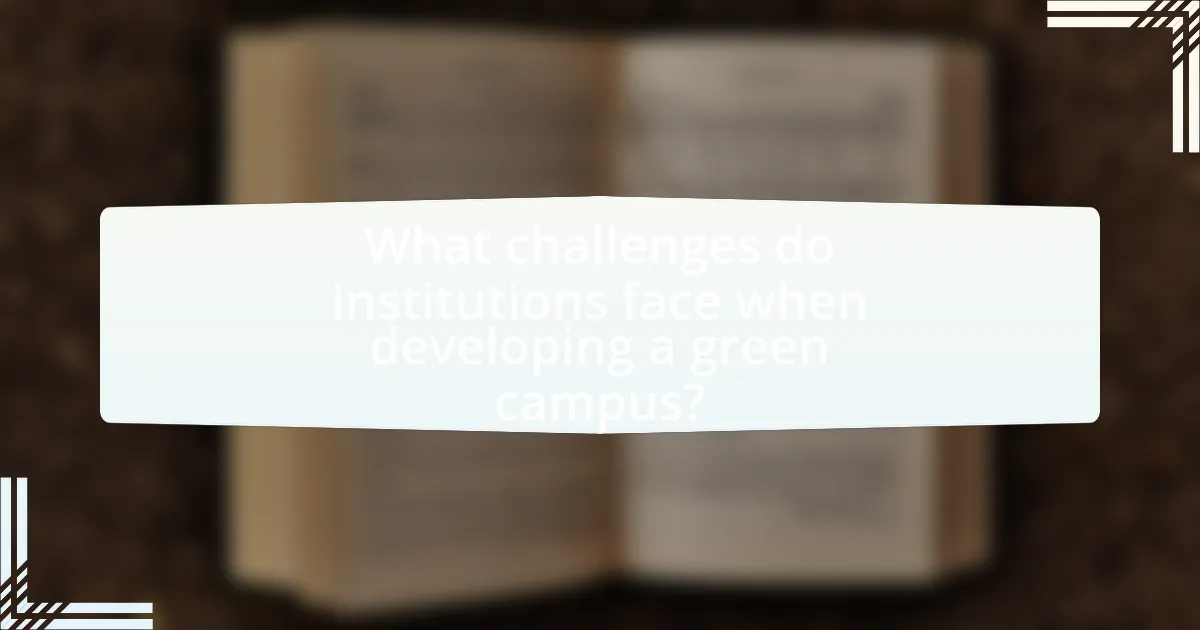Developing a green campus refers to the creation of environmentally sustainable educational environments that minimize ecological impact and promote conservation through practices such as energy-efficient buildings, waste reduction, and renewable energy use. This article outlines the importance of green campuses for educational institutions, highlighting their benefits for student well-being, environmental conservation, and operational cost reduction. It also discusses key principles of sustainability, innovative technologies, and best practices for implementation, while addressing challenges such as financial constraints and stakeholder engagement. Additionally, the article emphasizes the role of partnerships and community involvement in advancing sustainability initiatives on campuses.

What does it mean to develop a green campus?
Developing a green campus means creating an environmentally sustainable educational environment that minimizes ecological impact and promotes conservation. This involves implementing practices such as energy-efficient buildings, waste reduction programs, sustainable landscaping, and the use of renewable energy sources. For instance, according to the Association for the Advancement of Sustainability in Higher Education, campuses that adopt green building standards can reduce energy consumption by up to 30%. These initiatives not only enhance the campus’s ecological footprint but also foster a culture of sustainability among students and staff.
Why is developing a green campus important for educational institutions?
Developing a green campus is important for educational institutions because it promotes sustainability, enhances student well-being, and reduces operational costs. Sustainable practices, such as energy-efficient buildings and waste reduction, contribute to environmental conservation and can lead to significant cost savings; for instance, the University of California, Irvine reported a 30% reduction in energy costs after implementing green initiatives. Additionally, green campuses improve air quality and provide natural spaces that support mental health and academic performance, as studies show that access to green spaces can increase student focus and reduce stress levels.
What environmental benefits does a green campus provide?
A green campus provides significant environmental benefits, including reduced carbon emissions, improved biodiversity, and enhanced resource efficiency. By implementing sustainable practices such as energy-efficient buildings and renewable energy sources, green campuses can lower greenhouse gas emissions by up to 30% compared to traditional campuses. Additionally, the incorporation of green spaces and native plant landscaping promotes biodiversity, supporting local ecosystems and wildlife. Efficient water management systems, such as rainwater harvesting and drought-resistant landscaping, further enhance resource efficiency, reducing water consumption by as much as 50%. These practices collectively contribute to a healthier environment and a more sustainable future.
How does a green campus impact student well-being and learning?
A green campus positively impacts student well-being and learning by enhancing mental health, promoting physical activity, and improving academic performance. Research indicates that exposure to green spaces reduces stress and anxiety, leading to better mental health outcomes for students. For instance, a study published in the Journal of Environmental Psychology found that students with access to green areas reported higher levels of satisfaction and lower levels of stress. Additionally, green campuses encourage physical activity through walking paths and recreational areas, which are linked to improved cognitive function and concentration. A report from the American College Health Association highlights that students who engage in regular physical activity tend to achieve higher grades. Therefore, the integration of green spaces on campuses fosters an environment conducive to both well-being and academic success.
What are the key principles of a green campus?
The key principles of a green campus include sustainability, resource efficiency, and community engagement. Sustainability focuses on minimizing environmental impact through practices such as reducing waste, conserving energy, and promoting biodiversity. Resource efficiency emphasizes the optimal use of materials and energy, often achieved through renewable energy sources and sustainable transportation options. Community engagement involves fostering a culture of environmental awareness and participation among students, faculty, and staff, which can be supported by educational programs and collaborative initiatives. These principles are essential for creating an environmentally responsible and resilient campus that contributes positively to the surrounding community and ecosystem.
How do sustainability and eco-friendliness play a role in campus development?
Sustainability and eco-friendliness are integral to campus development as they guide the design and operation of educational environments to minimize environmental impact. Implementing sustainable practices, such as using renewable energy sources, promotes energy efficiency and reduces carbon footprints. For instance, a study by the Association for the Advancement of Sustainability in Higher Education found that campuses adopting green building standards, like LEED certification, can achieve energy savings of 30% or more compared to conventional buildings. Additionally, incorporating green spaces and sustainable landscaping enhances biodiversity and improves air quality, contributing to the overall well-being of the campus community. These practices not only align with global sustainability goals but also foster a culture of environmental responsibility among students and staff.
What are the essential components of a green campus design?
The essential components of a green campus design include sustainable building materials, energy-efficient systems, water conservation practices, waste reduction strategies, and biodiversity enhancement. Sustainable building materials, such as recycled or locally sourced products, minimize environmental impact. Energy-efficient systems, like solar panels and LED lighting, reduce energy consumption and greenhouse gas emissions. Water conservation practices, including rainwater harvesting and drought-resistant landscaping, help manage water resources effectively. Waste reduction strategies, such as composting and recycling programs, minimize landfill contributions. Finally, biodiversity enhancement through native plant landscaping and green spaces supports local ecosystems. These components collectively contribute to a sustainable and environmentally friendly campus.

What best practices should be followed in developing a green campus?
To develop a green campus, institutions should implement sustainable practices such as utilizing renewable energy sources, promoting biodiversity, and enhancing waste management systems. Utilizing renewable energy, like solar panels, can significantly reduce carbon footprints; for instance, campuses that have adopted solar energy have reported reductions in energy costs by up to 30%. Promoting biodiversity through native landscaping not only supports local ecosystems but also reduces water usage by 50% compared to traditional landscaping. Additionally, enhancing waste management systems by implementing recycling and composting programs can lead to a 40% reduction in landfill waste, as evidenced by universities that have adopted zero-waste initiatives. These practices collectively contribute to a more sustainable and environmentally friendly campus.
How can institutions effectively implement sustainable practices?
Institutions can effectively implement sustainable practices by integrating sustainability into their core operations and decision-making processes. This can be achieved through establishing clear sustainability goals, engaging stakeholders, and adopting best practices such as energy efficiency measures, waste reduction programs, and sustainable transportation options. For instance, a study by the Association for the Advancement of Sustainability in Higher Education (AASHE) found that institutions that set measurable sustainability targets and involve the campus community in initiatives see a significant increase in participation and success rates. Additionally, implementing renewable energy sources, such as solar panels, can reduce carbon footprints and operational costs, as evidenced by the University of California’s commitment to achieving carbon neutrality by 2025.
What role does energy efficiency play in a green campus?
Energy efficiency is crucial in a green campus as it significantly reduces energy consumption and greenhouse gas emissions. By implementing energy-efficient technologies and practices, campuses can lower operational costs and enhance sustainability. For instance, according to the U.S. Department of Energy, energy-efficient buildings can reduce energy use by 30% to 50%, leading to substantial cost savings and a smaller carbon footprint. This aligns with the goals of a green campus, which aims to promote environmental stewardship and resource conservation.
How can water conservation be achieved on campus?
Water conservation on campus can be achieved through implementing efficient irrigation systems, promoting water-saving fixtures, and encouraging behavioral changes among students and staff. Efficient irrigation systems, such as drip irrigation and rainwater harvesting, reduce water waste by delivering water directly to plant roots and utilizing natural precipitation. Installing water-saving fixtures, like low-flow faucets and dual-flush toilets, can significantly decrease water usage; for instance, low-flow faucets can save up to 60% more water compared to standard models. Additionally, educational campaigns that raise awareness about water conservation practices can foster a culture of sustainability, leading to reduced water consumption across the campus.
What innovative technologies can enhance green campus initiatives?
Innovative technologies that can enhance green campus initiatives include solar energy systems, smart building technologies, and sustainable transportation solutions. Solar energy systems, such as photovoltaic panels, can significantly reduce a campus’s carbon footprint by generating renewable energy; for instance, universities like the University of California, San Diego, have installed solar panels that produce over 30% of their energy needs. Smart building technologies, which utilize sensors and automation to optimize energy use, can lead to energy savings of up to 30% in existing buildings, as demonstrated by the implementation of energy management systems at institutions like Stanford University. Additionally, sustainable transportation solutions, including electric vehicle charging stations and bike-sharing programs, promote eco-friendly commuting options, as seen in campuses like the University of Michigan, which has integrated extensive bike lanes and electric vehicle infrastructure to reduce reliance on fossil fuels.
How can renewable energy sources be integrated into campus infrastructure?
Renewable energy sources can be integrated into campus infrastructure through the installation of solar panels, wind turbines, and geothermal systems. For instance, solar panels can be placed on rooftops or in open spaces to harness sunlight, while wind turbines can be installed in areas with sufficient wind flow to generate electricity. Geothermal systems can utilize the earth’s stable temperatures for heating and cooling buildings. According to the U.S. Department of Energy, campuses that adopt these technologies can significantly reduce their carbon footprint and energy costs, with some institutions achieving up to 50% energy savings.
What smart technologies can support sustainability efforts?
Smart technologies that can support sustainability efforts include Internet of Things (IoT) devices, smart grids, and energy management systems. IoT devices enable real-time monitoring of energy consumption and resource usage, allowing for data-driven decisions that reduce waste. Smart grids enhance the efficiency of electricity distribution by integrating renewable energy sources and optimizing energy flow. Energy management systems provide analytics and control over energy use, leading to significant reductions in carbon footprints. For instance, a study by the International Energy Agency found that smart grid technologies can reduce greenhouse gas emissions by up to 30% in urban areas.

What challenges do institutions face when developing a green campus?
Institutions face several challenges when developing a green campus, including financial constraints, regulatory hurdles, and stakeholder engagement. Financially, the initial investment for sustainable infrastructure can be significant, often deterring institutions from pursuing green initiatives. Regulatory hurdles arise from navigating complex environmental laws and building codes that may not support innovative green designs. Additionally, engaging stakeholders, such as students, faculty, and the local community, can be difficult, as differing priorities and levels of commitment may hinder collaborative efforts. These challenges are well-documented in studies, such as the “Green Campus: A Guide to Sustainable Campus Development” by the Association for the Advancement of Sustainability in Higher Education, which highlights the importance of addressing these barriers for successful implementation.
What financial obstacles hinder the development of green campuses?
High initial capital costs hinder the development of green campuses. These costs include investments in renewable energy systems, sustainable building materials, and advanced waste management technologies, which can be significantly higher than traditional options. For instance, a study by the U.S. Green Building Council indicates that green building projects can incur up to 10-20% more in upfront costs compared to conventional buildings. Additionally, limited access to funding and financial incentives for sustainability initiatives further complicates the financial landscape, as many institutions struggle to secure grants or loans specifically for green projects.
How can institutions secure funding for sustainability projects?
Institutions can secure funding for sustainability projects by applying for grants, forming partnerships with private sector organizations, and leveraging government incentives. Numerous foundations and government agencies offer grants specifically aimed at sustainability initiatives; for example, the U.S. Environmental Protection Agency provides funding opportunities through its Environmental Education Grants program. Additionally, collaborations with businesses can lead to sponsorships or co-funding arrangements, as companies often seek to enhance their corporate social responsibility profiles. Furthermore, institutions can take advantage of tax credits and rebates available for energy-efficient upgrades, which can significantly reduce project costs and attract further investment.
What are the costs associated with implementing green technologies?
The costs associated with implementing green technologies include initial capital investment, ongoing maintenance expenses, and potential training costs for staff. Initial capital investment can range from thousands to millions of dollars, depending on the technology, such as solar panels or energy-efficient systems. For example, the National Renewable Energy Laboratory reported that the average cost of solar photovoltaic systems was approximately $3,000 to $4,000 per installed kilowatt in 2020. Ongoing maintenance expenses can vary, with estimates suggesting that maintenance for renewable energy systems can be around 1-2% of the initial investment annually. Additionally, training costs for staff to effectively operate and maintain these technologies can add to the overall financial burden, often requiring specialized training programs that can cost several thousand dollars.
What social and cultural barriers exist in promoting a green campus?
Social and cultural barriers in promoting a green campus include resistance to change, lack of awareness, and differing values regarding environmental sustainability. Resistance to change often stems from established habits and routines among students and staff, making it difficult to adopt new eco-friendly practices. Lack of awareness about the benefits of a green campus can hinder participation in sustainability initiatives, as individuals may not understand the positive impact on health and the environment. Additionally, differing cultural values can lead to varying levels of commitment to sustainability, with some communities prioritizing economic growth over environmental concerns. These barriers can significantly impede the implementation of green initiatives on campuses.
How can institutions engage the campus community in sustainability efforts?
Institutions can engage the campus community in sustainability efforts by implementing participatory programs that encourage active involvement and collaboration. For example, universities can establish sustainability committees that include students, faculty, and staff to foster a sense of ownership and responsibility towards environmental initiatives. Research indicates that campuses with active sustainability committees report higher levels of community engagement and successful implementation of green practices, such as recycling programs and energy conservation initiatives. Additionally, hosting workshops, sustainability fairs, and awareness campaigns can effectively raise awareness and motivate individuals to participate in sustainability efforts, leading to a more environmentally conscious campus culture.
What strategies can be employed to overcome resistance to change?
To overcome resistance to change, effective strategies include clear communication, stakeholder involvement, and providing training. Clear communication ensures that all stakeholders understand the reasons for the change and its benefits, which can reduce uncertainty and fear. Involving stakeholders in the change process fosters a sense of ownership and commitment, making them more likely to support the initiative. Providing training equips individuals with the necessary skills and knowledge to adapt to the new changes, thereby increasing confidence and reducing resistance. Research indicates that organizations that prioritize these strategies experience higher success rates in implementing change initiatives, as evidenced by a study published in the Journal of Organizational Change Management, which found that effective communication and stakeholder engagement significantly correlate with successful change outcomes.
What practical steps can institutions take to ensure successful green campus development?
Institutions can ensure successful green campus development by implementing comprehensive sustainability plans that include energy efficiency, waste reduction, and sustainable transportation initiatives. For instance, adopting renewable energy sources, such as solar panels, can significantly reduce carbon footprints; a study by the U.S. Department of Energy found that solar energy can lower energy costs by up to 75%. Additionally, institutions should establish recycling programs and composting initiatives to minimize waste, as research indicates that effective waste management can reduce landfill contributions by 30% or more. Furthermore, promoting public transportation, biking, and walking can enhance campus accessibility while decreasing greenhouse gas emissions; a report from the National Center for Sustainable Transportation highlights that campuses with robust transportation programs see a 20% increase in sustainable commuting. By integrating these practical steps, institutions can create a more sustainable and environmentally friendly campus.
How can institutions create a comprehensive sustainability plan?
Institutions can create a comprehensive sustainability plan by conducting a thorough assessment of their current environmental impact and setting clear, measurable goals for improvement. This involves evaluating energy consumption, waste management, water usage, and transportation practices. For instance, a study by the Association for the Advancement of Sustainability in Higher Education (AASHE) indicates that institutions that implement sustainability assessments can identify key areas for reduction and improvement, leading to a 20-30% decrease in energy use over five years. Additionally, engaging stakeholders, including students, faculty, and community members, fosters collaboration and ensures diverse perspectives are considered in the planning process. By integrating sustainability into the institution’s mission and operations, institutions can create a roadmap that aligns with broader environmental goals, ultimately contributing to a more sustainable campus.
What role do partnerships play in advancing green campus initiatives?
Partnerships play a crucial role in advancing green campus initiatives by facilitating resource sharing, expertise exchange, and collaborative problem-solving. These collaborations often involve universities partnering with local governments, non-profit organizations, and businesses to implement sustainable practices, such as renewable energy projects and waste reduction programs. For instance, a study by the Association for the Advancement of Sustainability in Higher Education (AASHE) found that campuses engaged in partnerships reported a 30% increase in sustainability project success rates compared to those working independently. This demonstrates that partnerships enhance the effectiveness and reach of green initiatives, ultimately contributing to a more sustainable campus environment.

Leave a Reply